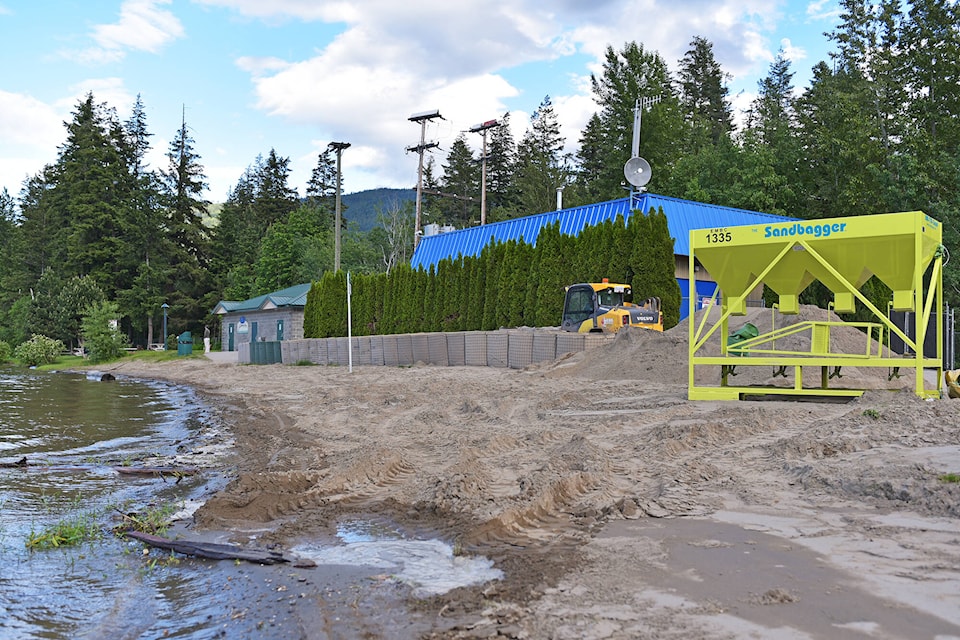By Salmon Arm Mayor Alan Harrison
Water. How does it get from its’ source to your tap?
Our primary source of water is Shuswap Lake. Three-hundred and sixty-five metres (1,200 feet) out and 24 metres (80 feet) down, off the beach at Canoe, is the City of Salmon Arm’s water intake. The intake pipe is 1,000 mm (3 feet) in diameter.
When you go to Canoe Beach, you see the pump house immediately on your right as you exit the tunnel under the tracks. You can hear the large pump kick on, with a loud hum, as it pulls in water.
This raw water is pumped to the water treatment plant immediately beside the Canoe Beach parking lot. When the water enters the plant, it goes through a series of flocculation treatments and filter beds, which helps purify the water. This is followed by UV light and sodium hypochlorite treatments.
The clean, treated water then exits the plant. There are two large pump stations that pump the water west and east to reservoirs located throughout Salmon Arm. There are eight main reservoirs, most located in city parks like Little Mountain and Pileated Woods.
City water is pumped long distances. From Canoe through Salmon Arm, out the Salmon Valley and parts of Gleneden, throughout North Broadview, through the Southeast sector; Hillcrest and to the industrial park.
It is important that city reservoirs are filled daily, to meet both the needs of residents and in case of fire.
A small supplementary reservoir is located at Metford Dam in South Canoe. The treatment plant there is smaller, but similar to the one at Canoe. Water can be used from Metford Dam, when the dam is full, following freshet.
All city water users help pay for the system.
Most residential properties pay an annual utility bill or user fee. This year’s fee was $292, minus 10 per cent if paid by February 15 (this year, 84 per cent of users took advantage of this early payment savings). For less than a dollar a day, it is an economical system. Some users have opted for metered billing (all Strata’s are also metered). Metered users pay bi-monthly, based on consumption.
On your annual tax bill, all properties who have water piping along their frontage pay a water-frontage tax. Depending on the size of your lot, you may pay for a minimum of 50 feet, to a maximum of 300 ft. Strata’s have a minimum frontage of 25 feet. The cost per taxable foot is $2.08. My frontage is 74 feet, so I pay $153.92 annually. This pays for the capital costs of the system. All parcels, residential/businesses/industry etc., pay frontage tax.
The water utility is independent of general municipal taxation (the sewer utility is as well). What this means is the water utility must balance – so the city collects as much revenue as is needed to operate the water system.
There are two major water projects that need to be completed in the next two years. The first is Pump Station #5, which is located underground at the Five Corners intersection of South Broadview. The pumps at the station need replacing, and we need to increase capacity. This pump station ships water throughout the immediate area as well as Hillcrest and the industrial park. We are going to relocate this pump station to Little Mountain, closer to the reservoir. Cost: about $2.5 million.
The second major project is to replace Pump Station #2, which is located at Canoe Beach and pumps the water to reservoirs throughout the city. This infrastructure is 50 years old and needs a complete upgrade. Again, the cost is over $2 million.
These projects are paid through development cost charges, which developers pay when developing new properties, and through water frontage tax revenues. To ensure both present and future residents pay their share, the city amortizes the cost over 30 years. The city spends over $4,000,000 per year on its water utility to provide safe drinking water to the community.
Thank you to our city water treatment and utility employees, who operate and monitor the utility, 24 hours a day, 365 days a year.
Read more: Salmon Arm looks to borrow $2.3 million for ‘essential’ water infrastructure project
Read more: Police costs in 2022 make up big chunk of proposed Salmon Arm tax increase
Sign up for our newsletter to get Salmon Arm stories in your inbox every morning.
